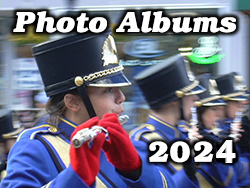
(above) The volunteer firemen of Washington Engine Company #1 pose in front of their East Milton Avenue firehouse circa 1880.
A History of the Rahway Fire Department
Submitted by Al Shipley, City Historian and Rahway Library Research Consultant
Records of local town meetings dating back to the late seventeen-hundreds mention the payment of wages to a constable who was entrusted with duties that included sounding an alarm if he spotted a fire. Upon hearing his signal, men would run to the scene hauling buckets of water. This was Rahway’s only method of fighting fires until 1813 when the citizens, seeking better fire protection, acquired a hand-drawn water pump. The new piece of apparatus was little more than a tub on wheels with a hand pump that still had to be filled by the bucket brigade.
In 1815, after failures to control several fires, Washington Engine Company #1, Rahway’s first volunteer squad, was established to more effectively utilize and more efficiently maintain the pump. They stored their equipment in a garage-type structure by the Monroe Street Bridge near the corner of Dock Street. In 1840 the company moved to a larger building on Main Street located on the approximate site of the present fire headquarters. In the early 1860s Washington Company erected Rahway’s first firehouse, a brick building on the corner of West Milton Avenue and Augusta Street which was in use until the 1970s.
The first apparatus capable of drafting water from the river was purchased in 1826 by Franklin Engine Company #2 which had its beginnings in 1823. By 1868 Franklin Company built a modern station on Seminary Avenue that was in use until the late 1970s. The city later sold the building which still stands after having been renovated into a multi-purpose property while maintaining the façade of the old firehouse.
Along with the Washington and Franklin Companies, the Eagle Engine Company #3, organized in 1835, would build their station on Main Street in the 1860s using the same building plan that was used for the East Milton station. It was located between the railroad tracks and Elizabeth Avenue on the site where it stands today. Independence Hook and Ladder Company # 1 (1850), Eagle Hose Company # 3 (1856), Washington Hose Company #1 (1856), and Franklin Hose Company # 2 (1856) would come into existence as new apparatus was acquired.
After the city was incorporated in 1858, these volunteer groups turned their equipment over to the city and became subject to the ordinances of the municipality. By 1859 the Rahway Fire Department consisted of three hose companies, two hook and ladder companies, and one hand engine company. Two-hundred and five volunteers made up these units. Twenty-five men were assigned to each hose company, fifty to the engine company, and forty to each hook and ladder company.
Before the end of the nineteenth century, several other companies were organized, some took on new names, and some dissolved. The Vulcan Engine Company #4, organized in 1858, was manned by the employees of a carriage spring factory. The Liberty Engine Company #5, in action from 1858 – 1874, was run by a group called “The Rangers.” The Excelsior Hook and Ladder Company existed for only three years (1875 – 1878). The Eagle Hose Company reorganized in 1883 and became Protection Hose Company #3. The Washington Hook and Ladder Company, the Washington Chemical Engine, and the Lincoln Hook and Ladder Company #2 were the last of the volunteer units to organize.
By 1911 there were seven volunteer companies, each a loyal brotherhood that took great pride in their commitment to protect the citizenry by being “first to the fire.” Their esprit de corps was so strong, they were known to reject the assistance of other units from both inside and outside the city limits when fighting a blaze. One such incident occurred on May 30, 1911 when a large fire broke out at the Royal Manufacturing Company located on East Grand Avenue just east of the railroad tracks. As the Rahway boys were battling the fire, an employee of Royal, fearing combustible material stored in an adjacent out-building might be touched off, contacted the Elizabeth Fire Department requesting help. Before long, horse-drawn engines from Elizabeth came charging down Grand Avenue. When they reached the site, several fireman dropped their hoses, stopped the out-of-towners, and confronted them declaring, ”Your services are not needed and not welcome.” The Elizabeth firefighters were outraged but turned and left. At the next meeting of the Elizabeth Council the Rahway volunteers were admonished for their “ungentlemanly behavior.”
After the Royal fire, nine of Rahway’s largest manufacturing companies approached the Common Council requesting they institute a paid fire department. It was their position that such a change would give them better protection and savings in insurance costs. In twelve years, a paid department would become a reality and the volunteer units a part of the past.
In mid – March, 1923, Mayor James B. Thurber reintroduced discussions of revamping the fire department. The volunteers were outraged and filed a petition to recall the mayor. After much debate and political haranguing, a majority of commissioners sided with Mayor Thurber and on May 18, 1923 voted to establish a paid department as a better way to “insure the safety to lives and property.” The department would consist of a chief, two assistants, six firemen, and 100 call men. This latter group would consist of former volunteers. Rahway’s first chief, Walter Ritzman, would be paid a maximum salary of $3,000.00 a year. Annual salaries for the two assistants would be $2,300.00, the six firemen would receive $1,500.00, and each call man $300.00.
In the years that followed, the department has continually upgraded and expanded its equipment and improved and increased the training of its firefighters. From the 1920s and into the 1950s, three stations were in operation (Seminary, Main and E. Milton) until 1956 when the Maple Avenue station was opened to cover the large housing developments that were built in the western part of the city. In 1977 a new fire headquarters was built on Main Street at the corner of Emerson Avenue that along with the Maple Avenue station were capable of handling the needs of the entire city. The three original stations were abandoned.
Today’s department is fully equipped with two modern engines, a 95’ ladder truck, and an assortment of specialized rescue vehicles needed for responding to all types of fires and floods. Rahway’s fifty-one firefighters protect the city 24/7 by working four shifts with twelve members covering each shift. All are EMT trained and operate as first responders for EMS. They are also trained in Haz-Mat, confined space rescue, and swift water rescue.





